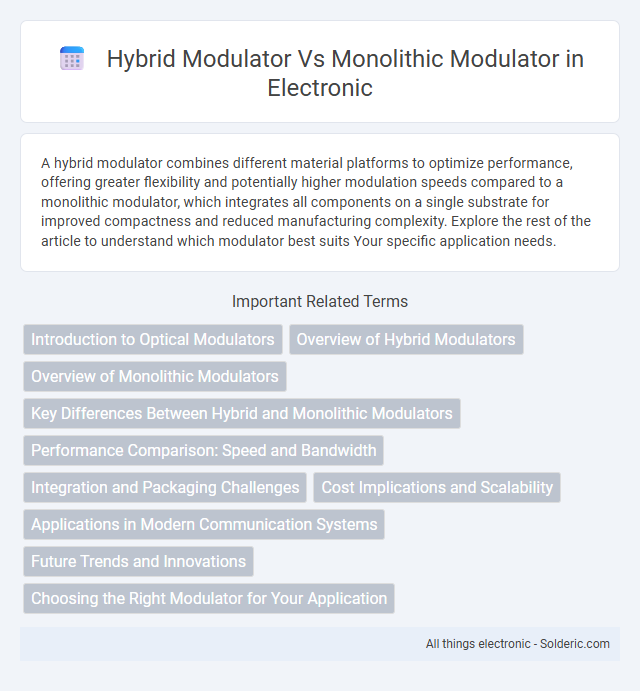A hybrid modulator combines different material platforms to optimize performance, offering greater flexibility and potentially higher modulation speeds compared to a monolithic modulator, which integrates all components on a single substrate for improved compactness and reduced manufacturing complexity. Explore the rest of the article to understand which modulator best suits Your specific application needs.
Comparison Table
| Feature | Hybrid Modulator | Monolithic Modulator |
|---|---|---|
| Integration | Combines multiple materials or components separately fabricated | Single substrate with integrated components |
| Performance | Higher flexibility in material choice, potentially better performance | Consistent performance due to unified fabrication |
| Complexity | More complex assembly and alignment needed | Simpler fabrication process |
| Cost | Generally higher due to multiple fabrication steps | Lower cost from single-step manufacturing |
| Size | Potentially larger footprint due to separate components | Smaller, compact design |
| Reliability | Dependent on assembly precision | Higher due to monolithic structure |
| Application | Custom or high-performance uses | Mass production and integration-friendly |
Introduction to Optical Modulators
Optical modulators control light properties such as amplitude, phase, or polarization in photonic systems, playing a critical role in high-speed data transmission and signal processing. Hybrid modulators combine different material platforms like silicon and lithium niobate to optimize performance, offering enhanced modulation efficiency and bandwidth compared to monolithic modulators, which are fabricated entirely on a single substrate. The integration strategies in hybrid modulators enable superior electro-optic coefficients and lower insertion loss, making them pivotal for next-generation optical communication technologies.
Overview of Hybrid Modulators
Hybrid modulators combine different material systems, such as silicon and lithium niobate, to leverage the advantages of each for high-speed, low-loss optical signal modulation. These devices offer improved bandwidth and integration flexibility compared to monolithic modulators fabricated from a single material substrate. Your choice of a hybrid modulator can enhance overall performance in applications requiring efficient optical communication and signal processing.
Overview of Monolithic Modulators
Monolithic modulators integrate all optical and electronic components on a single chip, enhancing performance through reduced signal loss and improved bandwidth. These devices offer compact size, increased stability, and lower manufacturing costs compared to hybrid modulators, which combine discrete components. Your communication system benefits from the efficiency and reliability of monolithic modulators in high-speed optical networks.
Key Differences Between Hybrid and Monolithic Modulators
Hybrid modulators combine separate optical and electronic components into one system, offering flexibility in material choice and potentially better performance in specific applications. Monolithic modulators integrate all components on a single chip, resulting in compact size, lower insertion loss, and easier mass production. Understanding these key differences helps you select the optimal modulator for your optical communication needs based on integration level, performance, and cost.
Performance Comparison: Speed and Bandwidth
Hybrid modulators generally offer higher speed and broader bandwidth than monolithic modulators due to their ability to integrate materials with superior electro-optic properties, such as lithium niobate, onto silicon platforms. Their enhanced performance enables modulation speeds exceeding 100 GHz, while monolithic modulators, typically limited by the material properties of silicon alone, usually operate below 60 GHz bandwidth. These advantages make hybrid modulators a preferred choice for high-speed optical communication systems requiring ultra-wide bandwidth and low modulation latency.
Integration and Packaging Challenges
Hybrid modulators face significant integration and packaging challenges due to the need to combine multiple discrete components, often leading to increased complexity and alignment issues that affect performance and reliability. Monolithic modulators integrate all functionalities on a single chip, simplifying packaging and enhancing compactness while minimizing optical losses caused by inter-component interfaces. For your applications requiring high stability and reduced footprint, monolithic modulators offer superior integration advantages over hybrid designs.
Cost Implications and Scalability
Hybrid modulators offer cost advantages by utilizing separate components that can be individually optimized and sourced, reducing initial manufacturing expenses compared to the monolithic approach. Scalability is more flexible with hybrid modulators since their modular design allows for easier upgrades and customization to meet varying application demands. In contrast, monolithic modulators require complex fabrication processes that increase costs and limit scalability due to the integrated nature of the device, restricting adaptability for large-scale production.
Applications in Modern Communication Systems
Hybrid modulators offer enhanced flexibility and integration capabilities, making them ideal for complex, high-speed optical communication systems requiring precise phase and amplitude control. Monolithic modulators provide superior compactness and stability, which is essential for mass-produced telecommunication devices and data centers where reliability and cost-efficiency are critical. Both modulators play pivotal roles in 5G networks, coherent optical transmission, and photonic integrated circuits, but hybrid designs often lead in performance-intensive scenarios while monolithic solutions dominate large-scale deployments.
Future Trends and Innovations
Hybrid modulators leverage the integration of diverse materials and components to enhance performance, facilitating advancements in speed, bandwidth, and energy efficiency critical for next-generation optical communication systems. Monolithic modulators, built on a single semiconductor platform, benefit from improved fabrication techniques and materials like silicon photonics and lithium niobate, driving miniaturization and mass production capabilities. Emerging innovations focus on hybrid-monolithic architectures combining the scalability of monolithic devices with the versatility of hybrid integration, enabling future trends such as programmable photonics, AI-enhanced modulation, and seamless integration with electronic circuits for advanced data processing.
Choosing the Right Modulator for Your Application
Selecting between a hybrid modulator and a monolithic modulator depends on your application's specific requirements for integration, performance, and scalability. Hybrid modulators offer flexibility by combining discrete components, enabling tailored configurations and ease of repair, while monolithic modulators provide superior compactness, stability, and reduced insertion loss through integrated fabrication. Careful evaluation of factors such as power handling, signal bandwidth, and environmental conditions ensures you choose the modulator that best aligns with your system's operational goals.
Hybrid modulator vs monolithic modulator Infographic

 solderic.com
solderic.com